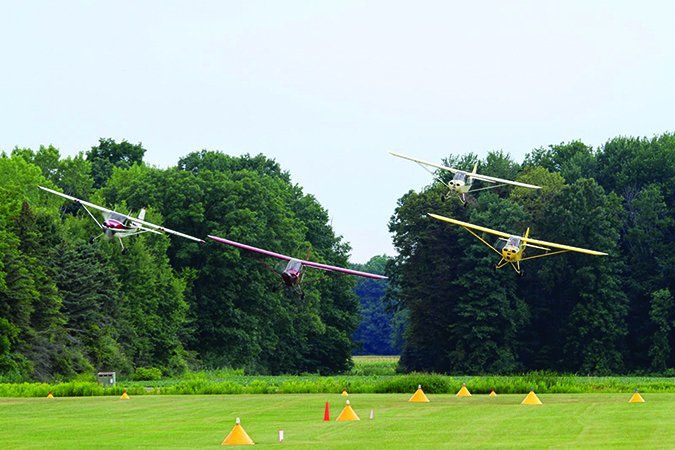Spend enough time at a non-towered airport, as I have, and you’ll eventually see every traffic-pattern variation you thought possible. Traffic patterns at towered facilities, of course, are subject to ATC management. The controller’s job is to sequence and separate traffic on the runway(s). In the absence of local controllers, non-towered airports use the traffic-pattern procedures first drummed into primary students during landing practice.
But it often seems that knowledge somehow is lost once the student graduates from training; rated pilots seem to be the worst offenders when it comes to deviating from standard traffic patterns. To a seasoned observer, it can be hard to determine if a well-defined traffic pattern even exists at some airports. My observations tell me the pattern diagram below may be one of the few things pilots retain from their training; everything else seems to have been lost, like a paper sectional after a door pops open. So it’s time to review traffic pattern operations.
D. Miller/Creative Commons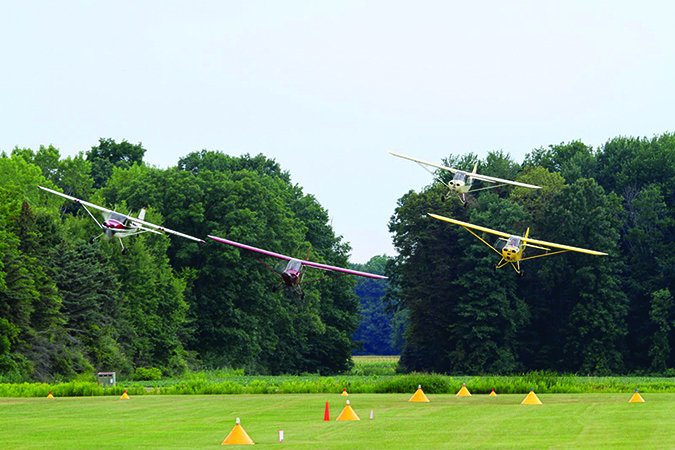
Resources
Perhaps most common among the various transgressions pilots commit in the pattern is turning the wrong way—making left turns when right ones are specified. The sidebar on the opposite page should serve as a good refresher on where and how to find information on airports with non-standard traffic patterns (i.e., right turns).
Of course, there’s much more to flying traffic patterns than turning in the correct direction. Chapter 4 of the FAA’s Aeronautical Information Manual (AIM) and Advisory Circular AC 90-66A, Recommended Standard Traffic Patterns and Practices for Aeronautical Operations at Airports Without Operating Control Towers, describe the procedures for flying a traffic pattern at a non-towered airport.
These resources state that, at most airports, the traffic pattern altitude for propeller-driven general aviation aircraft is typically 1000 feet agl and that traffic pattern altitudes for military turbojet aircraft extend up to 2500 feet agl. Using a common traffic pattern altitude is an important factor in minimizing the risk of collisions at airports without an operating control tower. The diagram below is adapted from those resources and depicts how to correctly enter and fly in the traffic pattern.
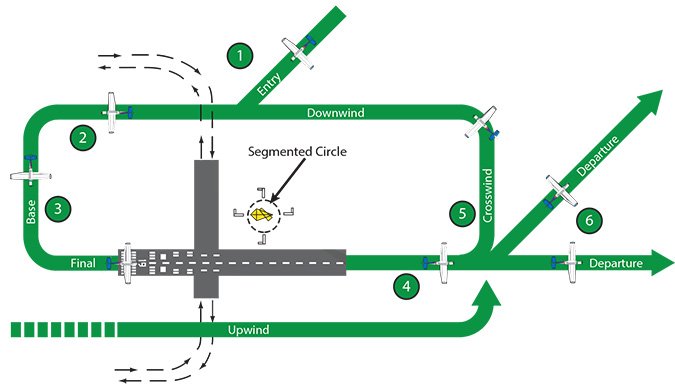
1—Enter the pattern in level flight; do not dive down from a higher altitude. Enter abeam the midpoint of the runway on downwind at pattern altitude.
2—Maintain pattern altitude until abeam the approach end of the landing runway.
3—Complete the turn from left base to final at least mile from the runway.
4—Continue straight ahead beyond the departure end of the runway.
5—If remaining in the traffic pattern, commence the turn to crosswind beyond the departure end of the runway within 300 ft of pattern altitude.
6—If departing the traffic pattern, continue straight out or exit with a 45-degree turn (to the left when in a left-hand traffic pattern; to the right when in a right-hand traffic pattern) beyond the departure end of the runway after reaching pattern altitude.
Altitude, Distance Guides
Note the recommended altitudes as cited in the figure for turning from the upwind leg to the crosswind leg is within 300 feet of traffic pattern altitude. Similarly, when leaving the traffic pattern, the airplane should be at traffic pattern altitude. A primary reason for these altitudes is to minimize risk of a midair collision in the traffic pattern.
Turning to crosswind or turning to depart the traffic pattern at an inappropriately low altitude, for example 200 feet agl, risks climbing up and colliding with other aircraft in the traffic pattern. However, if at a tower-controlled airport ATC directs a pilot to turn at lower altitudes than as stated in Figure 2, then this directive supersedes the stated altitudes and pilots are expected to immediately comply.
Recommendations for flying in the traffic pattern are also provided in the FAA’s Airplane Flying Handbook. As stated, compliance with the basic rectangular traffic pattern reduces the possibility of conflicts at airports without an operating control tower. Diving entries into a traffic pattern while descending above an airport, for example, from 2000 feet agl to 1000 feet agl, create specific collision hazards and should always be avoided. The downwind leg should be flown approximately to one nm out from the landing runway and at a specified pattern altitude (airport elevation in msl plus 1000 feet). For example, if airport elevation is 200 feet msl, then the recommended traffic pattern altitude is 1200 feet msl.
Traffic pattern altitude should be maintained until abeam the approach end of the landing runway. At this position, power should be reduced and a descent initiated. The downwind leg should be continued to a point approximately 45 degrees from the approach end of the runway, and a medium bank is made onto the base leg. A gradual descent should continue on the base leg.
At all points in the pattern but especially when approaching the position from which a turn from base to final is initiated, the pilot must be looking for traffic along the final approach course. Straight-in approaches to the runway may be conducted at any time, and are completely legal. Traffic using a straight-in approach may be executing an instrument approach to that runway—in any weather. The pilot in the pattern must be scanning for traffic and ensure there is no danger of colliding with another aircraft that may already be on final approach.
I’ve observed a number of pilots flying small single-engine airplanes incorrectly fly two to three nm out from the runway on downwind and base legs, as well as fly too high or low by about 200 to 400 feet. By turning from downwind to base three miles from the runway, and not self-announcing on the radio, these pilots risk colliding with pilots flying appropriately closer traffic patterns ( to one nm). A pilot flying a closer traffic pattern and on base leg may not see an airplane coming from behind on a three-mile base leg, predisposing to a midair collision.
For those flying inappropriately high or low altitudes in the traffic pattern, when queried during flight reviews, a common response I’ve heard is, “I don’t know how to determine the altitude.” Such a response reveals inadequate preflight planning and poor situational awareness, but it also highlights the pilot either was never properly trained how to fly a traffic pattern or forgot that training.
Traffic Patterns 101
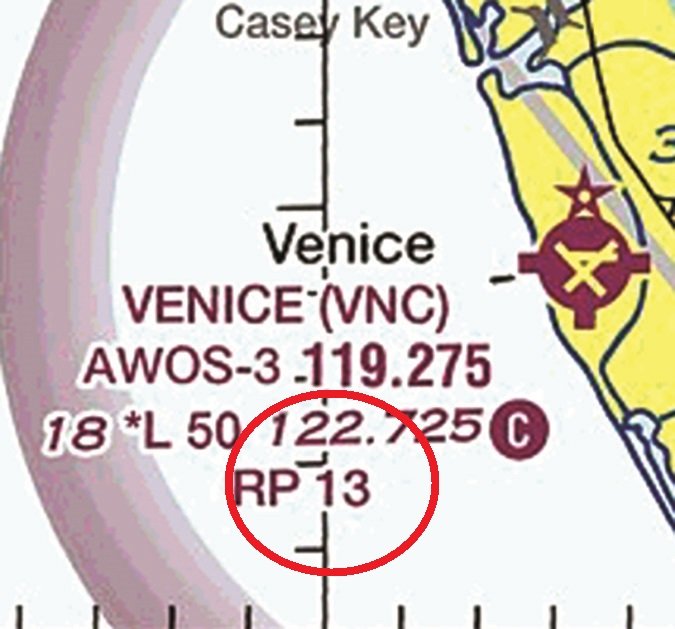
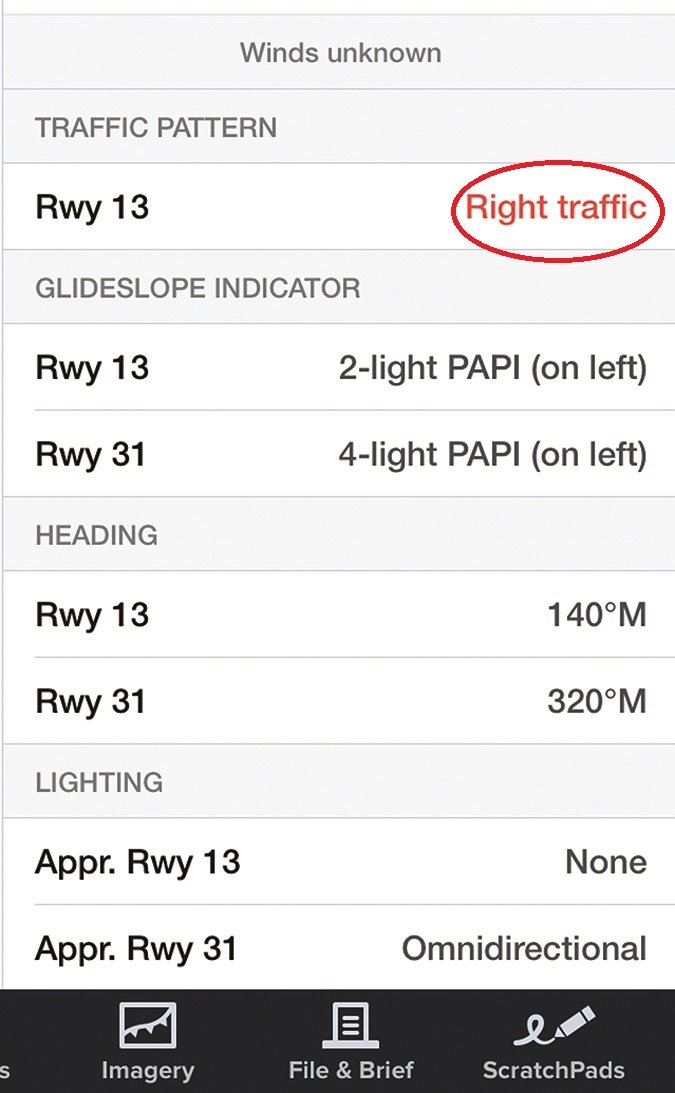
– FARs 91.126 and 91.127 mandate that pilots at Class E or G airports “make all turns…to the left unless the airport displays approved light signals or visual markings indicating that turns should be made to the right….”
– Do the regulations mean a pilot must fly a downwind-to-base-to-final traffic pattern at a non-towered airport? No; using a standard traffic pattern is a recommendation.
– Preflight planning should include traffic pattern directions for runways at departure and destination airports if the airport is in Class G and Class E airspace.
– Many electronic flight bag applications highlight runways at which right turns are specified. ForeFlight displays “Right traffic” in red.
– Some airports employ a segmented circle adjacent to the runway with L-shaped traffic pattern indicators and a landing direction indicator (tetrahedron).
– When all else fails, observe the airport’s wind direction indicator (wind sock or wind cone) and obtain the automated weather information (ATIS, AWOS). You can determine the landing runway most aligned with the prevailing wind.
Unexpected Maneuvers
All pilots are expected to cooperate with the previously discussed rules and recommendations for flying in the traffic pattern to preclude disrupting the traffic flow, creating conflicts and flying sudden, unexpected maneuvers. While flying in the traffic pattern, especially at airports in Class G and E airspace, pilots should be vigilant of unexpected maneuvers of other pilots, like pilots who attempt to land downwind on the active runway. Another example is a pilot who suddenly makes a 180- or 360-degree turn while on downwind or base legs. This unexpected maneuver results in a gap in the landing interval with other traffic in the pattern and—more important—may cause a chain reaction resulting in conflicts with other traffic.
Airspeed
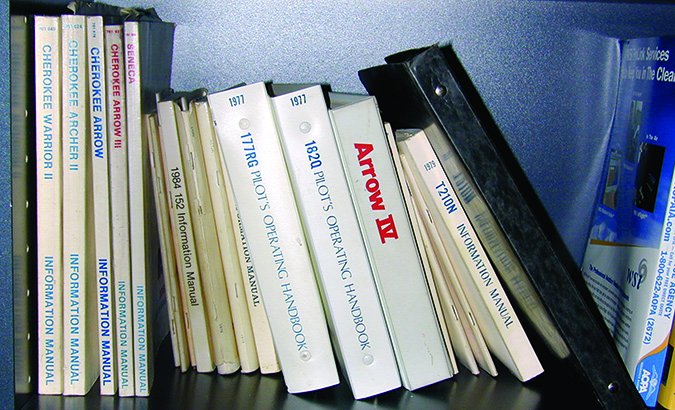
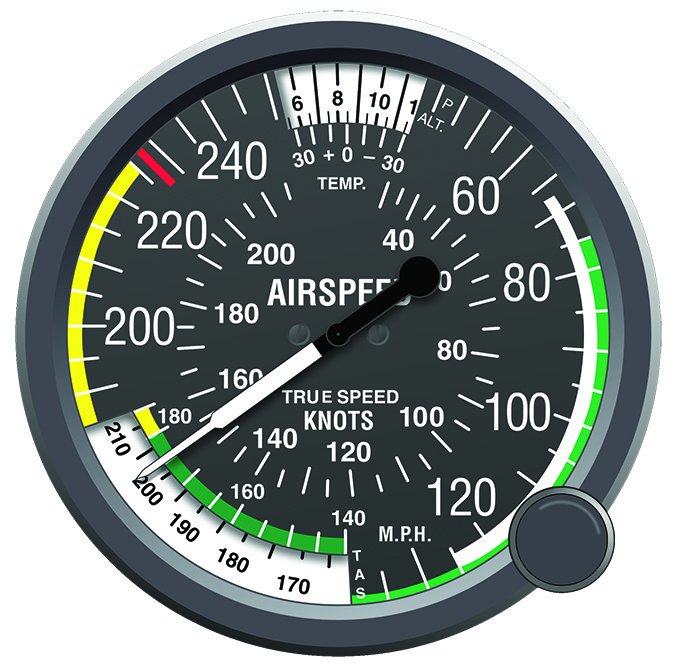
– It is important to fly traffic pattern legs at the recommended airspeeds as stated in an airplane’s Pilots Operating Handbook (POH). Proper energy management in the traffic pattern means to always use appropriate airspeeds, not excessive or insufficient ones.
– Flying too slowly risks a stall and in-flight loss of control in the traffic pattern. In the absence of stated traffic pattern airspeeds in the POH, the FAA’s Airplane Flying Handbook recommends using 1.4 VSO (VSO is the power-off stalling speed with landing gear and flaps down.) For example, if VSO is 50 KIAS, then 1.4 VSO = 70 KIAS.
– For the final approach leg, 1.3 VSO should be used. For example, if VSO is 50 KIAS, then 1.3 VSO X 50 knots = 65 KIAS.
– Most of us don’t have to worry about it, but there is maximum airspeed when approaching certain airports. FAR 91.117 requires that unless otherwise authorized or required by ATC, no person may operate an aircraft at or below 2500 feet agl and within four nm of the primary airport of a Class C or Class D airspace area at an indicated airspeed of more than 200 knots.
– There is no similar speed limit for airports in Class E or G airspace, except for the 250-KIAS speed limit imposed below 10,000 feet msl. That doesn’t mean you should go bombing around the traffic pattern at the speed of heat. At best, you’ll annoy people. At worst, you’ll swap paint with someone slower than you (and everyone will be slower than you).
Radio Operations
The recommended radio communication procedures also are stated in the AIM’s Chapter 4. The basic procedure is to use the CTAF at non-towered airports to self-announce when inbound at 10 nm from the airport by reporting the airplane’s identification and type, altitude, location relative to the airport, intentions (land or overfly) and possession of the automated weather information, if any. Additionally, pilots need to self-announce when entering the traffic pattern on the downwind, turning base, turning final and when clearing the runway.
For airports with an operating control tower, FAR 91.126 and 91.127 state “…no person may operate an aircraft to, from, through, or on an airport having an operational control tower unless two-way radio communications are maintained between the aircraft and control tower. Communications must be established prior to four nm from the airport, up to and including 2500 feet agl.”
Upon approaching these types of airports and at a distance of approximately 10 nm, the first radio call should be to communicate with the tower. If the tower is not in operation and there is no reply, the pilot should self-announce his/her intentions to the airport traffic using the CTAF. For example, “Lake City traffic, Skyhawk 1234, 10 northwest, at 3500 feet, inbound for landing, Lake City traffic.”
In a busy pattern, there’s a fine art to this. The pilot who drones on and on about where he is and what he’s going to do next eats into other pilots’ air time. Taking 10 seconds to deliver a travelogue for other traffic in the area is roughly twice as much time as you should use. Make your transmissions concise and only when necessary.
When not transmitting, listen. You likely will learn more about other airplanes’ positions and intentions by listening than in any other way. You’ll also learn how other pilots make their position/intention reports and whether their methods are better or worse than yours. Paying attention to how other pilots do it—whether well or poorly—gives you options for your own announcements. We’d also suggest the amount of time you should take announcing position and intentions is inversely proportional to how many aircraft there are in the pattern.
Instrument Traffic
Pilots flying a published instrument approach procedure—whether for practice or for real—typically fly a straight-in approach starting approximately 10 nm from a runway threshold. At non-towered airports, these pilots do not fly a normal traffic pattern. For flight safety and to alert other pilots in the traffic pattern, starting from at least 10 nm from the runway, pilots should self-announce on the CTAF their intentions of flying a straight-in instrument approach.
Because many pilots operating at a non-towered airport may not be instrument-rated—and even if they were, they don’t have the procedure in their lap for reference—avoid using certain terminology on the radio to represent position reports. For example, while flying the RNAV Runway 28 approach at Lake City, Fla., avoid stating “at Oreho” (intermediate fix) or “at Oppey” (final approach fix). This terminology is meaningless to non-instrument rated pilots. Rather, a pilot should state his/her position and altitude at 10 and five nm from the runway threshold, and then again while on short final.
Right-of-Way and the Straight-In Approach
The primary reason for FAR 91.113 is to mitigate the likelihood of a midair collision on final approach. The regulation states that when two or more aircraft are approaching an airport for the purpose of landing, the aircraft at the lower altitude has the right-of-way.
For example, a pilot turning onto short final while at an inappropriately high altitude of 800 to 1000 feet agl and intending to land in front of another airplane already established on short final at 500 feet agl is not in compliance with the regulation.
Additionally, the regulation states pilots are not to take advantage of this rule by cutting in front of or overtaking another aircraft on final approach to land.
Aleksander Markin/Creative COmmons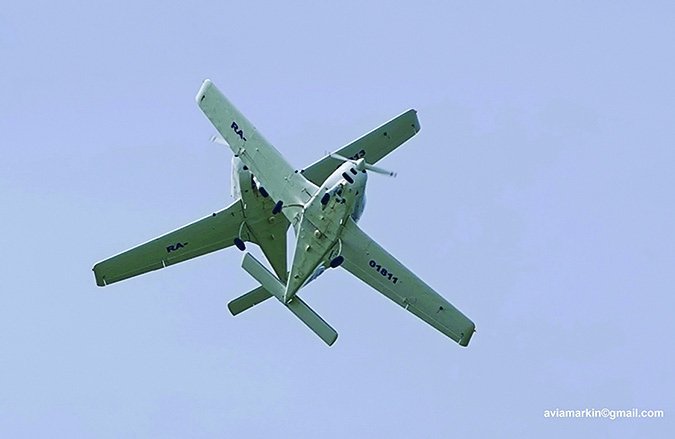
Take The Time
Flight safety in the traffic pattern requires pilots learn, review and be in compliance with FAA traffic pattern regulations and recommendations. We also must take the time before every flight to review the traffic procedures and pattern layouts at our departure and destination airports in Class G and Class E airspace.
This is in keeping with the FAA’s new compliance philosophy, an approach to ensure pilots meet regulatory standards. It uses safety management principles to ensure both compliance with regulations and identification of hazards and management of risk. It’s also a good operating practice, and your fellow pilots will thank you.
Dr. Banner is a flight instructor at University Air Center, Gainesville Regional Airport (GNV), Gainesville FL, professor at the University of Florida in Gainesville, and instructor pilot in the U.S. Air Force Auxiliary / Civil Air Patrol. A CFII and MEI, he has 5000 hours of flight time and owns a GCBC Citabria.

